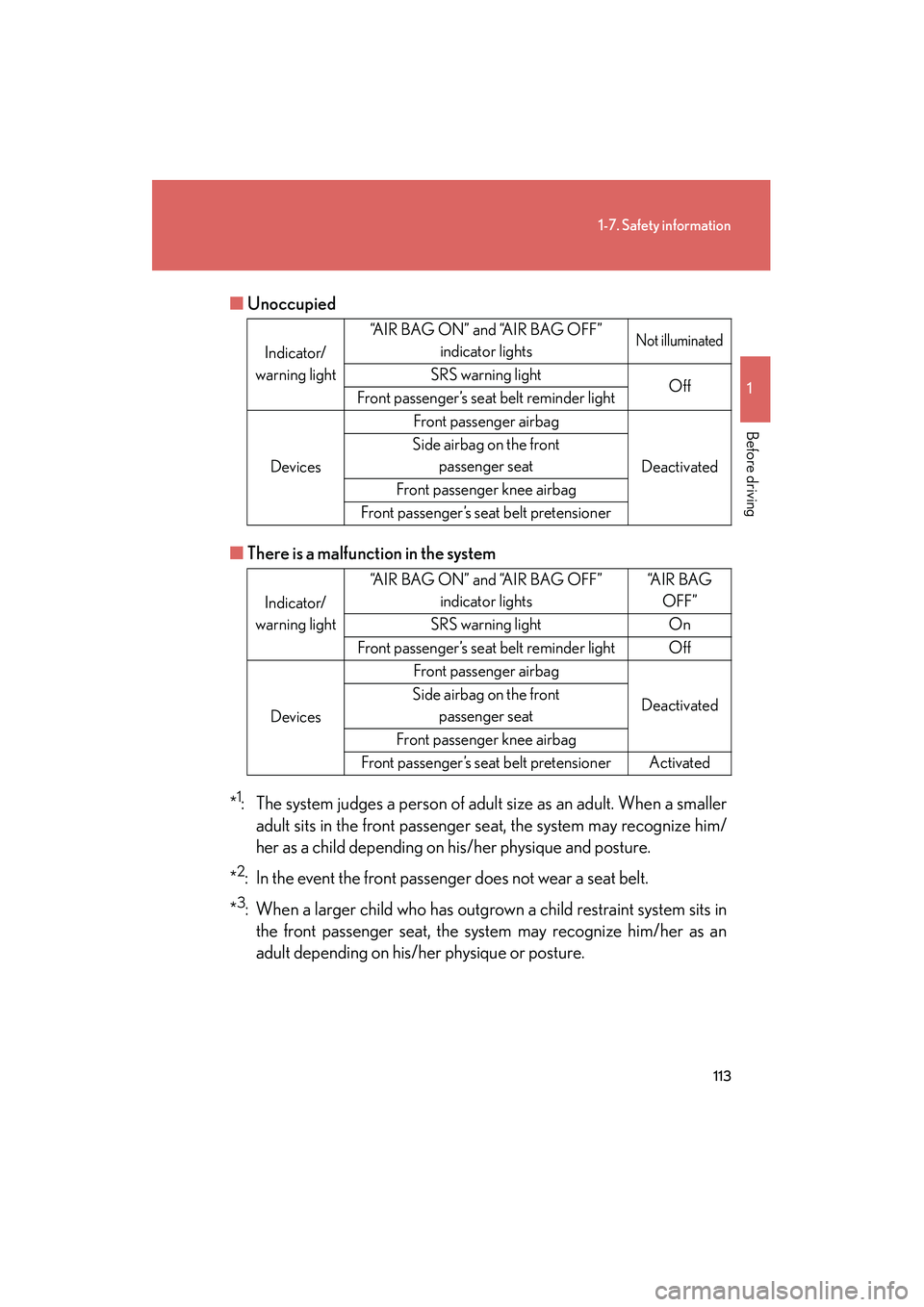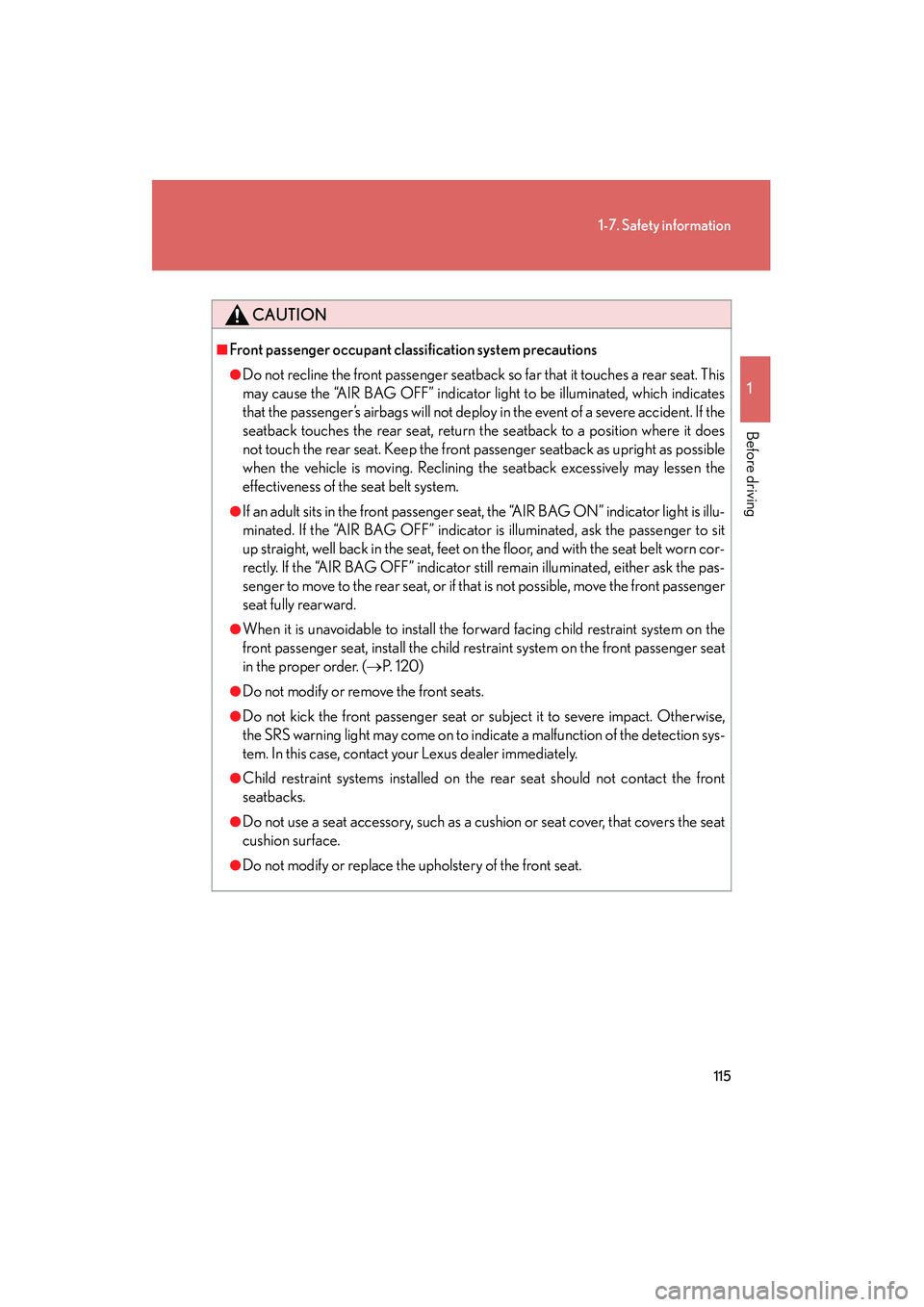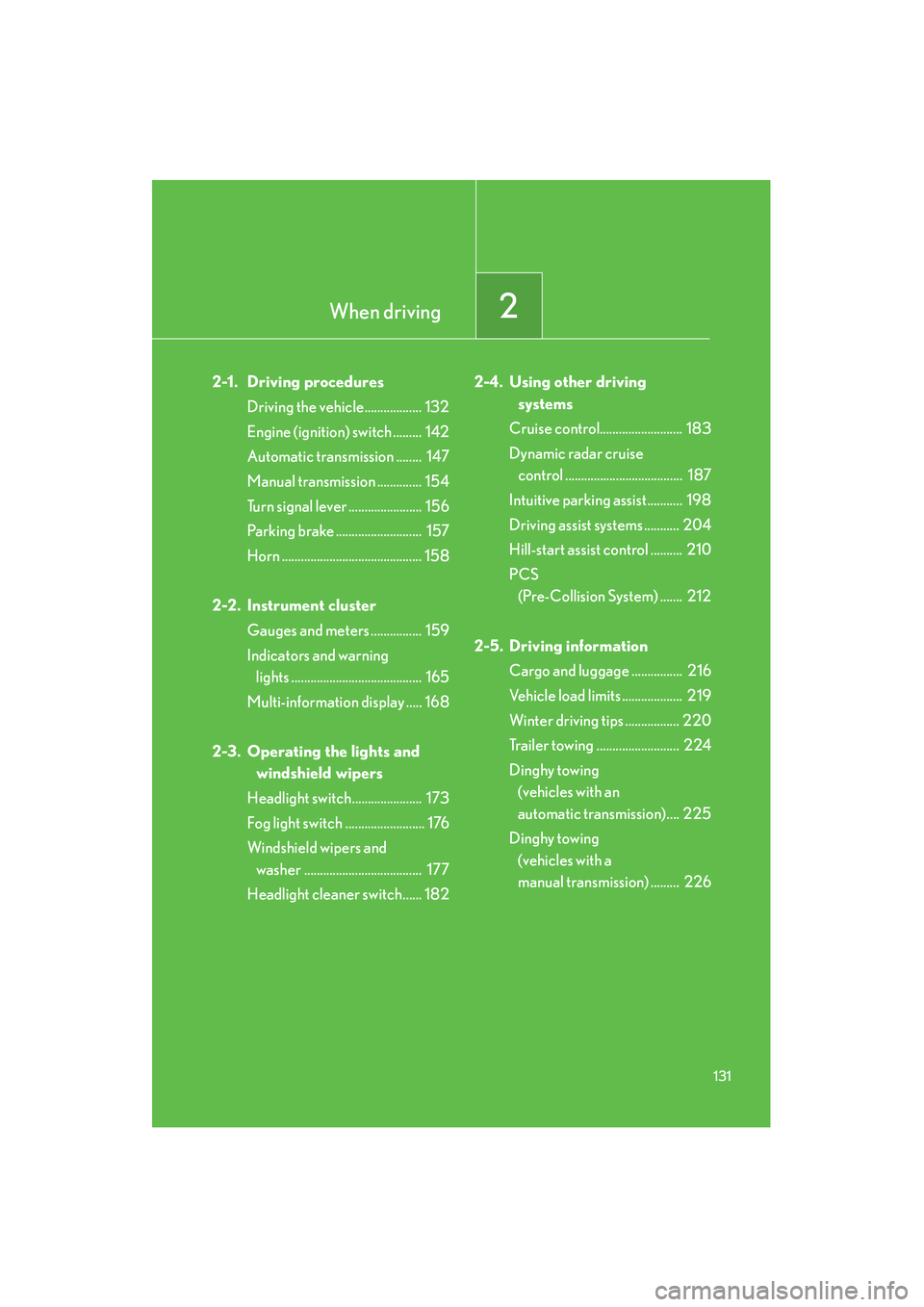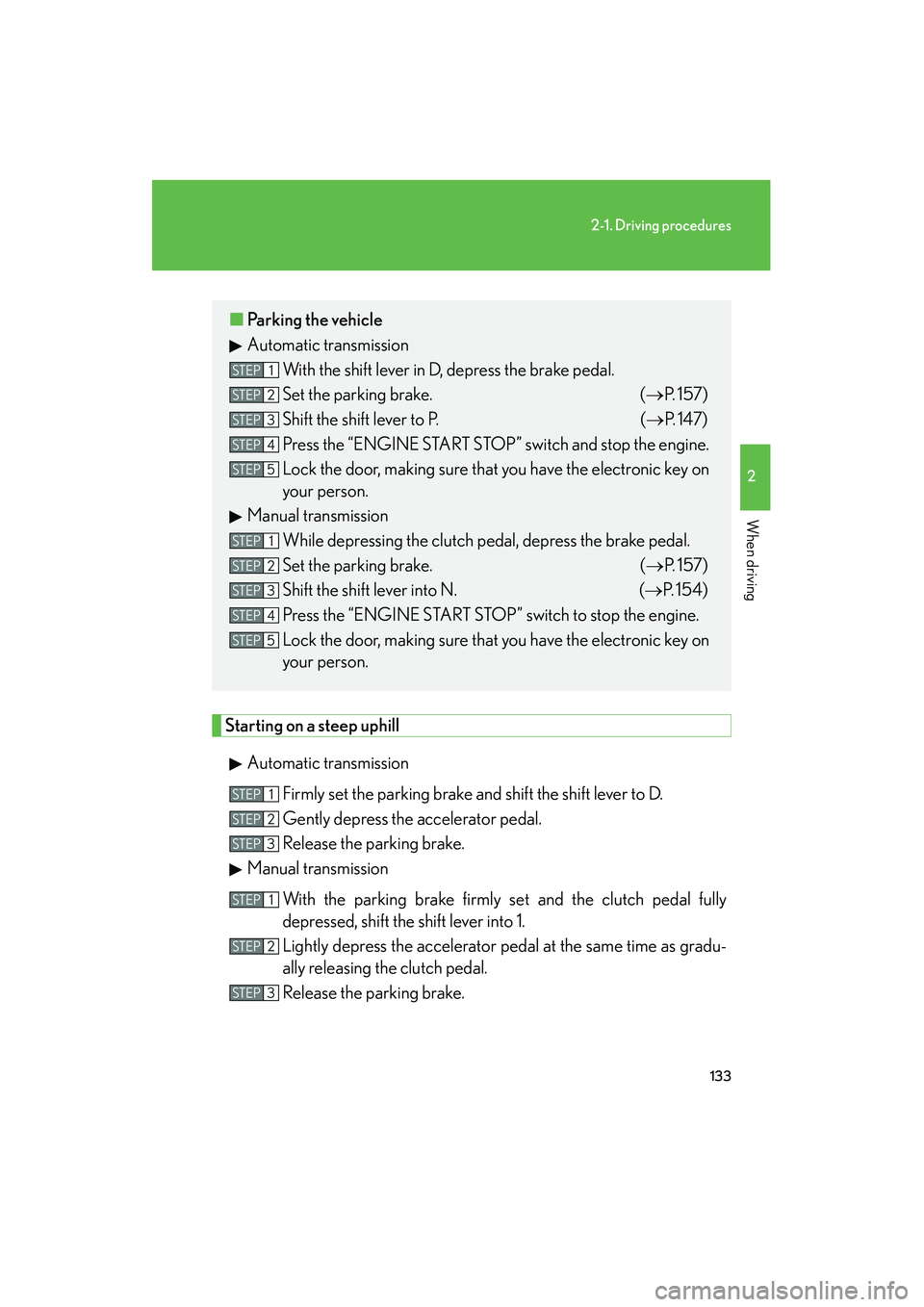light Lexus IS250C 2010 Owner's Guide
[x] Cancel search | Manufacturer: LEXUS, Model Year: 2010, Model line: IS250C, Model: Lexus IS250C 2010Pages: 586, PDF Size: 31.62 MB
Page 114 of 586

113
1-7. Safety information
1
Before driving
10_IS250C/350C_U■
Unoccupied
■ There is a malfunction in the system
*
1: The system judges a person of adult size as an adult. When a smaller adult sits in the front passenger seat, the system may recognize him/
her as a child depending on his/her physique and posture.
*
2: In the event the front passenger does not wear a seat belt.
*
3: When a larger child who has outgrown a child restraint system sits in the front passenger seat, the system may recognize him/her as an
adult depending on his/her physique or posture.
Indicator/
warning light “A I R B A G O N ” a n d “A I R B A G O F F ”
indicator lightsNot illuminated
SRS warning light Off
Front passenger’s seat belt reminder light
Devices Front passenger airbag
Deactivated
Side airbag on the front
passenger seat
Front passenger knee airbag
Front passenger’s seat belt pretensioner
Indicator/
warning light “A I R B A G O N ” a n d “A I R B A G O F F ”
indicator lights “A I R B A G
OFF”
SRS warning light On
Front passenger’s seat belt reminder light Off
Devices Front passenger airbag
Deactivated
Side airbag on the front
passenger seat
Front passenger knee airbag
Front passenger’s seat belt pretensioner Activated
Page 115 of 586

114
1-7. Safety information
10_IS250C/350C_U*
4: Never install a rear facing child restraint system on the front passen-
ger seat. A forward facing child restraint system should only be
installed on the front passenger seat when it is unavoidable.
(→ P. 1 1 6 )
*
5: In case the indicator is not illuminated, consult this manual as for installing the child restraint system properly. ( →P. 120)
CAUTION
■Front passenger occupant classification system precautions
Observe the following precautions regarding front passenger occupant classifica-
tion system.
Failure to do so may cause death or serious injury.
●Wear the seat belt properly.
●Make sure the front passenger’s seat belt tab has not been left inserted into the
buckle before someone sits in the front passenger seat.
●Make sure the “AIR BAG OFF” indicator light is not illuminated when using the
seat belt extender for the front passenger seat. If the “AIR BAG OFF” indicator
light is illuminated, disconnect the extender tongue from the seat belt buckle,
then reconnect the seat belt. Reconnect the seat belt extender after making sure
the “AIR BAG ON” indicator light is illuminated. If you use the seat belt extender
while the “AIR BAG OFF” indicator light is illuminated, the front passenger
airbag, side airbag on the front passenger side and front passenger knee airbag
may not activate correctly, which could cause death or serious injury in the event
of collision.
●Do not put weight on the front passenger seat by putting your hands or feet on
the front passenger seat seatback from the rear passenger seat.
●Do not let a rear passenger lift the front passenger seat with their feet or press on
the seatback with their legs.
●Do not put objects under the front passenger seat.
Page 116 of 586

115
1-7. Safety information
1
Before driving
10_IS250C/350C_U
CAUTION
■Front passenger occupant classification system precautions
●Do not recline the front passenger seatback so far that it touches a rear seat. This
may cause the “AIR BAG OFF” indicator light to be illuminated, which indicates
that the passenger’s airbags will not deploy in the event of a severe accident. If the
seatback touches the rear seat, return the seatback to a position where it does
not touch the rear seat. Keep the front passenger seatback as upright as possible
when the vehicle is moving. Reclining the seatback excessively may lessen the
effectiveness of the seat belt system.
●If an adult sits in the front passenger seat, the “AIR BAG ON” indicator light is illu-
minated. If the “AIR BAG OFF” indicator is illuminated, ask the passenger to sit
up straight, well back in the seat, feet on the floor, and with the seat belt worn cor-
rectly. If the “AIR BAG OFF” indicator still remain illuminated, either ask the pas-
senger to move to the rear seat, or if that is not possible, move the front passenger
seat fully rearward.
●When it is unavoidable to install the forward facing child restraint system on the
front passenger seat, install the child restraint system on the front passenger seat
in the proper order. (→P. 1 2 0 )
●Do not modify or remove the front seats.
●Do not kick the front passenger seat or subject it to severe impact. Otherwise,
the SRS warning light may come on to indicate a malfunction of the detection sys-
tem. In this case, contact your Lexus dealer immediately.
●Child restraint systems installed on the rear seat should not contact the front
seatbacks.
●Do not use a seat accessory, such as a cushion or seat cover, that covers the seat
cushion surface.
●Do not modify or replace the upholstery of the front seat.
Page 119 of 586

118
1-7. Safety information
10_IS250C/350C_U
CAUTION
■Child restraint precautions
●Lexus strongly urges the use of a proper child restraint system that conforms to
the size of the child, installed on the rear seat. According to accident statistics, the
child is safer when properly restrained in the rear seat than in the front seat.
●Never install a rear facing child restraint system on the front passenger seat even
if the “AIR BAG OFF” indicator light is illuminated. In the event of an accident, the
force of the rapid inflation of the front passenger airbag can cause death or seri-
ous injury to the child if the rear facing child restraint system is installed on the
front passenger seat.
●A forward facing child restraint system should be allowed to be installed on the
front passenger seat only when it is unavoidable. A child restraint system that
requires a top tether strap should not be used in the front passenger seat since
there is no top tether strap anchor for the front passenger seat. Adjust the
seatback as upright as possible and always move the seat as far back as possible
even if the “AIR BAG OFF” indicator light is illuminated, because the front pas-
senger airbag could inflate with considerable speed and force. Otherwise, the
child may be killed or seriously injured.
●Do not use the seat belt extender when installing a child restraint system on the
front or rear passenger seat. If installing a child restraint system with the seat belt
extender connected to the seat belt, the seat belt will not securely hold the child
restraint system, which could cause death or serious injury to the child or other
passengers in the event of an accident.
●Do not allow the child to lean his/her head or any part of his/her body against the
door or the area of the seat from which the side airbags deploy even if the child is
seated in the child restraint system. It is dangerous if the side airbags inflate, and
the impact could cause death or serious injury to the child.
●Make sure you have complied with all installation instructions provided by the
child restraint manufacturer and that the system is properly secured. If it is not
secured properly, it may cause death or serious injury to the child in the event of a
sudden stop or an accident.
Page 124 of 586

123
1-7. Safety information
1
Before driving
10_IS250C/350C_U
Installing child restraints using a seat belt (child restraint lock function belt)
■Rear facing Infant seat/convertible seat
Place the child seat on the rear
seat facing the rear of the vehicle.
Run the seat belt through the child
seat and insert the plate into the
buckle. Make sure that the belt is
not twisted.
Fully extend the shoulder belt and
then allow it to retract slightly in
order to activate the ALR lock
mode.
Lock mode allows the seat belt to
retract only.
STEP1
STEP2
STEP3
Page 125 of 586

124
1-7. Safety information
10_IS250C/350C_UWhile pushing the child seat down
into the rear seat, allow the shoul-
der belt to retract until the child
seat is securely in place.
After the shoulder belt has
retracted to a point where there is
no slack in the belt, pull the belt to
check that it cannot be extended.
■
Forward facing Convertible seat
Place the child seat on the seat
facing the front of the vehicle.
Run the seat belt through the child
seat and insert the plate into the
buckle. Make sure that the belt is
not twisted.
Fully extend the shoulder strap and
then allow it to retract slightly into
the ALR lock mode.
Lock mode allows the seat belt to
retract only.
STEP4
STEP1
STEP2
STEP3
Page 129 of 586

128
1-7. Safety information
10_IS250C/350C_U
CAUTION
■When installing a booster seat
Do not fully extend the shoulder belt to prevent the belt from going to ALR lock
mode: (→P. 6 7 )
ALR mode causes the belt to tighten only which could cause injury or discomfort to
the child.
■When installing a child restraint system
Follow the directions given in the child restraint system installation manual and fix
the child restraint system securely in place.
If the child restraint system is not correctly fixed in place, the child or other passen-
gers may be injured or even killed in the event of sudden braking or an accident.
●If the driver’s seat interferes with the child
restraint system and prevents it from being
attached correctly, attach the child restraint
system to the right-hand rear seat.
●Only put a forward facing child restraint
system on the front seat when unavoidable.
When installing a forward facing child
restraint system on the front passenger
seat, move the seat as far back as possible
even if the “AIR BAG OFF” indicator light is
illuminated. Failing to do so may result in
death or serious injury if the airbags deploy
(inflate).
Page 132 of 586

When driving2
131
10_IS250C/350C_U
2-1. Driving proceduresDriving the vehicle.................. 132
Engine (ignition) switch ......... 142
Automatic transmission ........ 147
Manual transmission .............. 154
Turn signal lever ....................... 156
Parking brake ........................... 157
Horn ............................................ 158
2-2. Instrument cluster Gauges and meters ................ 159
Indicators and warning lights ......................................... 165
Multi-information display ..... 168
2-3. Operating the lights and windshield wipers
Headlight switch...................... 173
Fog light switch ......................... 176
Windshield wipers and washer ..................................... 177
Headlight cleaner switch...... 182 2-4. Using other driving
systems
Cruise control.......................... 183
Dynamic radar cruise control ..................................... 187
Intuitive parking assist ........... 198
Driving assist systems ........... 204
Hill-start assist control .......... 210
PCS (Pre-Collision System) ....... 212
2-5. Driving information Cargo and luggage ................ 216
Vehicle load limits ................... 219
Winter driving tips ................. 220
Trailer towing .......................... 224
Dinghy towing (vehicles with an
automatic transmission).... 225
Dinghy towing (vehicles with a
manual transmission) ......... 226
Page 134 of 586

133
2-1. Driving procedures
2
When driving
10_IS250C/350C_U
Starting on a steep uphillAutomatic transmission Firmly set the parking brake and shift the shift lever to D.
Gently depress the accelerator pedal.
Release the parking brake.
Manual transmission
With the parking brake firmly set and the clutch pedal fully
depressed, shift the shift lever into 1.
Lightly depress the accelerator pedal at the same time as gradu-
ally releasing the clutch pedal.
Release the parking brake.
■Parking the vehicle
Automatic transmission
With the shift lever in D, depress the brake pedal.
Set the parking brake. (→P. 1 5 7 )
Shift the shift lever to P. (→ P. 147)
Press the “ENGINE START STOP” switch and stop the engine.
Lock the door, making sure that you have the electronic key on
your person.
Manual transmission
While depressing the clutch pedal, depress the brake pedal.
Set the parking brake. (→P. 1 5 7 )
Shift the shift lever into N. (→ P. 1 5 4 )
Press the “ENGINE START STOP” switch to stop the engine.
Lock the door, making sure that you have the electronic key on
your person.
STEP1
STEP2
STEP3
STEP4
STEP5
STEP1
STEP2
STEP3
STEP4
STEP5
STEP1
STEP2
STEP3
STEP1
STEP2
STEP3
Page 136 of 586

135
2-1. Driving procedures
2
When driving
10_IS250C/350C_U
CAUTION
■When starting the vehicle
With automatic transmission vehicles, always keep your foot on the brake pedal
while stopped with the engine running. This prevents the vehicle from creeping.
■When driving the vehicle
●Do not drive if you are unfamiliar with the location of the brake and accelerator
pedals to avoid depressing the wrong pedal.
• Accidentally depressing the accelerator pedal instead of the brake pedal willresult in sudden acceleration that may lead to an accident that could result in
death or serious injury.
• When backing up, you may twist your body around, leading to a difficulty in operating the pedals. Make sure to operate the pedals properly.
• Make sure to keep a correct driving posture even when moving the vehicle only slightly, allowing you to depress the brake and accelerator pedals prop-
erly.
• Depress the brake pedal using your right foot. Depressing the brake pedal using your left foot may delay response in an emergency, resulting in an acci-
dent.
●Do not drive the vehicle over or stop the vehicle near flammable materials.
●With automatic transmission vehicles, do not let the vehicle roll backwards while
the shift lever is in a driving position, or roll forward while the shift lever is in R.
Doing so may cause the engine to stall or lead to poor brake and steering perfor-
mance, resulting in an accident or damage to the vehicle.
●If the smell of exhaust is noticed inside the vehicle, open the windows and check
that the trunk is closed. Large amounts of exhaust in the vehicle can cause driver
drowsiness and an accident, resulting in death or a serious health hazard. Have
the vehicle inspected by your Lexus dealer immediately.
●Do not under any circumstances shift the shift lever to P, R or N (vehicles with an
automatic transmission) or R (vehicles with a manual transmission) while the vehi-
cle is moving.
Doing so can cause significant damage to the transmission system and may result
in a loss of vehicle control.
●Do not shift the shift lever to N while the vehicle is moving.
Doing so may cause the engine brake to not operate properly and lead to an
accident.